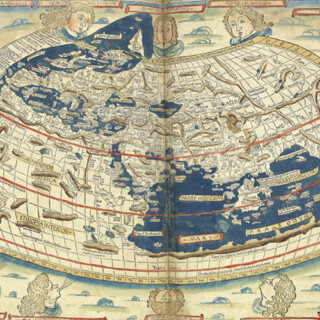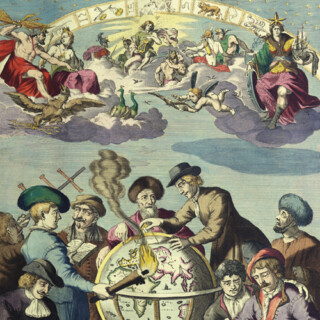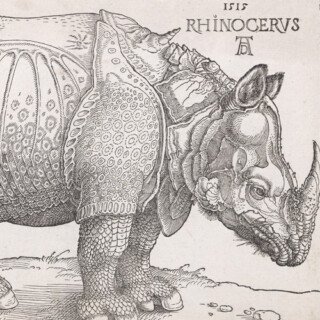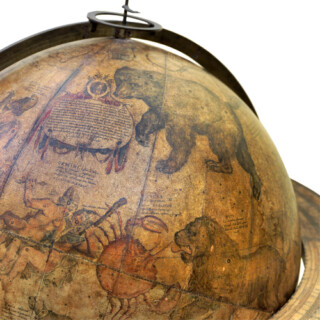Globus terrestris juxta observationes Parisienses Regia Academiae Scientiarum constructus.
Nuremberg,
Opera loh. Bapt. Homanni Geographi,
[c1702-1715].
Globe, 12 hand-coloured engraved paper gores, all housed within original black morocco over paste-board clamshell case, decorated with fine gilt foliate tools and fillets, with hook and eye, lined with two sets of 12 hand-coloured engraved celestial gores.
Diameter: 64mm (2.5 inches).
23370
notes:
The earliest state of Homann's only known pocket globe
Biography
Johann Baptist Homann (1664-1724) was a German geographer and cartographer. He was educated as a Jesuit and destined for an ecclesiastical career, but converted to Protestantism and then worked as a notary in Nuremberg. He founded a publishing business there in 1702, and published his first atlas in 1707, becoming a member of the Academy of Sciences in Berlin in the same year. He collabor...
Biography
Johann Baptist Homann (1664-1724) was a German geographer and cartographer. He was educated as a Jesuit and destined for an ecclesiastical career, but converted to Protestantism and then worked as a notary in Nuremberg. He founded a publishing business there in 1702, and published his first atlas in 1707, becoming a member of the Academy of Sciences in Berlin in the same year. He collabor...
bibliography:
Sumira 22; Dekker and van der Krogt, pl.20.
provenance:







![[HOMANN, Johann Baptist]. Globus terrestris juxta observationes Parisienses Regia Academiae Scientiarum constructus.](https://i0.wp.com/crouchrarebooks.com/wp-content/uploads/2025/03/23370_1H.jpg?fit=2284%2C3500&ssl=1)
![[HOMANN, Johann Baptist]. Globus terrestris juxta observationes Parisienses Regia Academiae Scientiarum constructus.](https://i0.wp.com/crouchrarebooks.com/wp-content/uploads/2025/03/23370_2H.jpg?fit=2735%2C2615&ssl=1)
![[HOMANN, Johann Baptist]. Globus terrestris juxta observationes Parisienses Regia Academiae Scientiarum constructus.](https://i0.wp.com/crouchrarebooks.com/wp-content/uploads/2025/03/23370_3H.jpg?fit=2589%2C2682&ssl=1)
![[HOMANN, Johann Baptist]. Globus terrestris juxta observationes Parisienses Regia Academiae Scientiarum constructus.](https://i0.wp.com/crouchrarebooks.com/wp-content/uploads/2025/03/23370_4H.jpg?fit=2688%2C2608&ssl=1)
![[HOMANN, Johann Baptist]. Globus terrestris juxta observationes Parisienses Regia Academiae Scientiarum constructus.](https://i0.wp.com/crouchrarebooks.com/wp-content/uploads/2025/03/23370_5H.jpg?fit=2683%2C2586&ssl=1)
![[HOMANN, Johann Baptist]. Globus terrestris juxta observationes Parisienses Regia Academiae Scientiarum constructus.](https://i0.wp.com/crouchrarebooks.com/wp-content/uploads/2025/03/23370_6H.jpg?fit=2697%2C2648&ssl=1)
![[HOMANN, Johann Baptist]. Globus terrestris juxta observationes Parisienses Regia Academiae Scientiarum constructus.](https://i0.wp.com/crouchrarebooks.com/wp-content/uploads/2025/03/23370_7H.jpg?fit=2690%2C2672&ssl=1)
![[HOMANN, Johann Baptist]. Globus terrestris juxta observationes Parisienses Regia Academiae Scientiarum constructus.](https://i0.wp.com/crouchrarebooks.com/wp-content/uploads/2025/03/23370_8H.jpg?fit=2933%2C3088&ssl=1)
![[HOMANN, Johann Baptist]. Globus terrestris juxta observationes Parisienses Regia Academiae Scientiarum constructus.](https://i0.wp.com/crouchrarebooks.com/wp-content/uploads/2025/03/23370_9H.jpg?fit=4000%2C2149&ssl=1)
![[HOMANN, Johann Baptist]. Globus terrestris juxta observationes Parisienses Regia Academiae Scientiarum constructus.](https://i0.wp.com/crouchrarebooks.com/wp-content/uploads/2025/03/23370_10H.jpg?fit=4000%2C2323&ssl=1)
